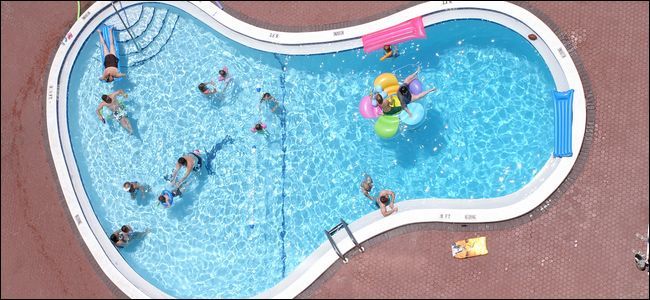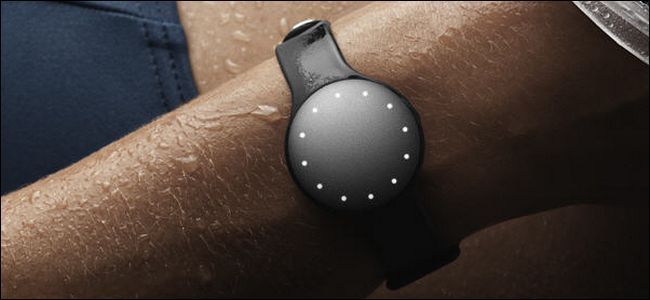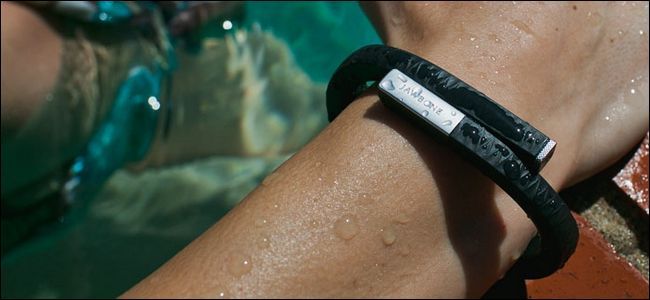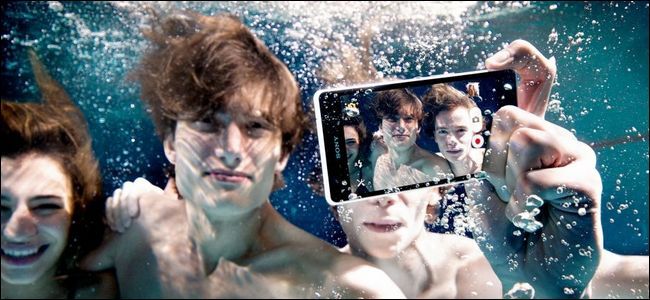Quick Links
The terms water-resistant and waterproof get bandied around quite a bit in the gadget market, but that doesn't mean you chuck your gadgets into the nearest pool with impudence. Water-resistance is most definitely not waterproof by any measure.
Last week we dove deep into the nomenclature and standards surrounding the testing and production of water-resistant gadgets. This week we're back with a lighter overview that's perfect for people looking for a broad overview of water-resistant gadgets without so many tables and technical specifications. Let's take a look at the most important things you need to know about water-resistance and your gadgets.
What's the Difference?
Every year thousands upon thousands of consumers fry their supposedly "waterproof" gadgets because of a poor understanding (on the part of the consumer) and poor marketing (on the part of the manufacturer). Understanding the basics of water-resistance is key to keeping your gadgets safe as well as purchasing the right gadgets for your outdoor and sport needs.
The most important thing you need to understand about the entire concept of "waterproof" is that it isn't a real thing outside of very misleading marketing material. There is no waterproof gadget on the market. Every single phone, watch, sport band, GPS device, portable speaker, or the like that bills itself as "waterproof" should really bill itself as "Water-resistant within the parameters specified by the manufacturer."
Think of it like "earthquake proof." It is impossible to build a structure that is completely impervious to earthquakes. No matter how well-built and over-engineered a structure may be there is always a combination of earthquake intensity and duration that will bring it to the ground. Water-resistance is exactly the same. Every "waterproof" gadget has a point where the it has been submerged too long, too deep, or in water too hot or too cold, and the seals on the device fail allowing water inside.
How Water Resistant Is My Gadget?
Now that the whole mess of "waterproof" is behind us we can focus on understanding what water-resistant actually means. Anybody can claim their device is water-resistant, but you shouldn't trust their claim without seeing how they define the water-resistance of their product.
There are two principal terms and ratings used to convey water-resistance. The first is Atmospheres (ATM) rating and the second is IP (Ingress Protection) rating. The two are rarely, if ever, used together and you're more likely to see an ATM rating on fitness-type gadgets like wrist-worn trackers as the ATM rating can be traced back to the early days of water-resistant watches. The IP rating is more commonly used for larger gadgets like phones, bluetooth speakers, and the like.
Water Resistance as Measured by ATM Rating
While the confusing world of "waterproof" gadgets is a relatively new one, ATM ratings have been misunderstood for ages because of confusion over what exactly the rating indicates. On the back of watches and fitness devices you will often seen a notation like "5 ATM" or "Water-Resistant to 50 Meters". Yet many a person has had their "waterproof" watch give up the ghost when they weren't scuba diving but just jumping off the high dive at the local pool.
The confusion arises because of what the "5 ATM" or "50 meters" indicates. It does not indicate that the device is water-resistant under all conditions to 50 meters below the surface of the water. It indicates that under static (nonmoving) conditions at 50 meters below the surface of the water the pressure of the water will not breach the seals on the device. If you were to take a spill while water skiing the moment you hit the water the pressure of the water hitting the device would be much higher than the static pressure at 50 meters of depth, and it's quite possible water could force its way into the device.
In short, the higher the better (with no exception). If you need water protection and there are two devices that meet your needs but one has a 10 ATM rating and one has a 5 ATM rating, don't think "Why would I need a 10 ATM rating? I'm just swimming laps!" Think "The higher the better; that'll keep the water out for sure!" as diving in a pool and recreational water sports can put a beating on your device that is as tough or tougher than deep water exposure.
Water Resistance as Measured by IP Rating
We'd love to say that the IP rating was less confusing than the ATM rating but it certainly isn't. The Ingress Protection code is an international standard that details how protected from physical and liquid ingress an object is. The rating is written in the format IPXY where X is resistance to physical ingress and Y is the resistance to liquid ingress. The higher the number the better in terms of protecting your gear.
Although IP ratings like IP12 exist, you won't generally see anything listed on a consumer electronic device lower than something like IP56 (which would indicate the device is almost entirely protected from dust and from jets of water). Typically if a manufacturer has taken the time to build and market a "waterproof" device they'll aim for IP68 which translates to "dust tight" and "immersion beyond 1 meter of depth under conditions specified by the manufacturer". The iPhone 7 is IP67, which means dust tight and immersion up to 1 meter.
The "conditions specified by the manufacturer" is the part that ends up the most confusing to consumers because what those specified conditions are can vary widely.
For further reading on the topic of ATM and IP ratings, definitely check out our article How Water Resistance Ratings Work for Gadgets for a full run down and charts detailing each level of ATM and IP certification and what it means under real world use.
The Resistance Level of Popular Water-Resistant Gadgets
While we can't detail the water-resistance ratings of every gadget you might consider purchasing we can highlight the ratings of various popular devices on the market and, in the process, help you to get a better sense of what those ratings actually mean in terms actual use.
Let's start off with a device that is practically guaranteed to come in contact with water at some point during its use.
Fitness Trackers
The recent surge in the wearables market means lots and lots of people are now wearing their fitness and activity trackers 24/7. Among the most popular are those in the Fitbit lineup but the water-resistance doesn't necessarily apply across the board with the Fitbit brand. The popular Fitbit Flex and the Fitbit Charge only have an ATM 1 rating and although the documentation on the product pages says they can be submerged up to 10 meters the Fitbit Help page answering the question "Can I swim or shower with my tracker?" clearly indicates that the 1 ATM rating is not sufficient enough to withstand the force of swimming strokes.
You can see how that's confusing to consumers when the product page says one thing (take it to 10 meters!) and the product help page says another, more accurate, thing (1 ATM is not sufficient resistance to withstand the pressure of a butterfly stroke!). Even the Fitbit Charge, which has an 5 ATM rating, is not rated for the pressure of swimming or watersports.
Jawbone also has a popular line of fitness trackers and they're much more transparent about the degree to which their devices are waterproofed: rather than label them "waterproof" or "water-resistant" they label them "Splash-Proof" which is an honest representation of their water rating. The Jawbone UP2, UP3, and UP Move are all rated to 5 ATM which means they are perfectly splashproof and will survive the sweatiest workout, a run in the rain, or a trip into the shower just fine. (But, like the Fitbit lineup, should not be used for swimming, diving, or watersports.)
Curiously the Misfit Shine and Misfit Flash are both approved for swimming by Misfit but only carry a 5 and 3 ATM rating, respectively. We chalk this support for swimming (absent in nearly every other fitness tracker) on the design of the device. The Shine and Flash are both portless (they have no charging or data port as they run off a coin cell battery for six months at a time and sync via Bluetooth).
Smart Watches
If ever there was a category of personal gadget that is both expensive and likely to be exposed to water, it would be smart watches. Given the high probability that even if you avoid wearing it in the pool you'll still end up getting it wet now and then while washing your hands or forgetting to take it off before getting in the shower, water-resistance is a key feature in pricey smart watches.
The Pebble, Pebble Steel, and the forthcoming Pebble Time are all rated for 5ATM and, as such, are perfectly splash proof for your kitchen cleaning and showering needs.
The vast majority of Android Wear watches on the market are at least IP55 (dust protected and resistant to powerful splashing) with the bulk of popular models rated for IP67 (dust tight and water-resistant for up to thirty minutes in 1 meter of water). The Moto 360 is IP67 as is the Samsung Gear, Gear 2, and Gear S.
The Apple Watch Series 1 is IP rated IPX7 (which means Apple didn't apply for a physical ingress protection rating but that the watch is submersible up to 1 meter like the aforementioned Android Wear watches). The Series 2 is water resistant to a depth of up to 50 meters.
Like the fitness trackers, we certainly wouldn't recommend testing whether or not your expensive watch can actually survive a half hour at 1 meter of depth per the IP specifications. It is nice to know, however, that the rating is there and that your watch will survive hand washing and showering just fine (and most likely survive and accidental dunk in the pool).
Smartphones
Water-resistant smartphones are becoming more popular, especially with the launch of the water-resistant iPhone 7. Right around the time phones matured to the point that they were viable camera replacements and indispensable social media centers is around the time companies started seriously entertaining the idea of building phones that could survive beach adventures.
Smartphone manufacturers don't use the ATM rating and instead use the IP rating system so they can specify both the physical and liquid protection offered by their device. As we mentioned above you will very rarely see a phone advertised as anything less than IP67 (which is really the only acceptable baseline for a device that might take a dunk in the pool with you as seen above).
The iPhone 7 has this exact rating--IP67. Some Android phones go a little further, with the Galaxy S7 and many Sony Xperia phones claiming IP68.
Curiously, Apple never applied for IP ratings before the iPhone 7, but there are informal reports that the iPhone 6's enhanced port gaskets and sealing render it splashproof and able to survive brief dunks (such as if you were to accidentally drop it in the sink while working in the kitchen). Officially, however, the iPhone is not water resistant and we strongly recommend getting a good water-resistant case if you have any intention of taking it near water.
Bluetooth Speakers
Another gear category that frequently carries an IP designation is Bluetooth speakers. While most water-resistant gadgets are water-resistant for the just-in-case moments (like falling in a pool with your phone in your pocket) Bluetooth speakers are intended to be hauled to the beach and used at poolside.
As such it's not unusual to find highly water-resistant speakers like those in the Braven line. We've previously reviewed the BRV-1 (which has a nice IPX7 rating) and highlighted the BRV-1 (also IPX7 rated) in our guide to Bluetooth speakers. We can definitely attest to how water-resistant the Braven BR line is as the BRV-1 has served as a shower sound system for the last year without issue.
Some companies go even further than just making their speakers splash proof, they combine splash proof with floating elements like the Nyne Aqua (which isn't just IPX7 rated, it also floats along on the surface of the pool right along with you).
In short: if water resistance is important to you always go with the highest rating available and always read the manufacturer's description of what that water resistance entails. For further reading check out How Water Resistance Ratings Work for Gadgets and if you'd like to temporarily waterproof your small electronics in an inexpensive and easily applied way, check out our discussion of dry bags here.
Image Credits: Kristin Nador, Misfit, Jawbone, Sony.




